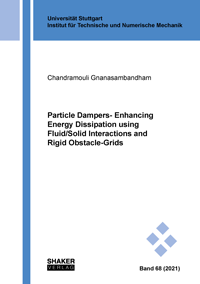
Shop : Details
Shop
Details
45,80 €ISBN 978-3-8440-8171-8Softcover148 pages70 figures218 g21 x 14,8 cmEnglishThesis
August 2021
Chandramouli Gnanasambandham
Particle Dampers- Enhancing Energy Dissipation using Fluid/Solid Interactions and Rigid Obstacle-Grids
Particle dampers (PDs) are a promising alternative to conventional dampers, due to their simple design and their flexible ability to dissipate energy over a wide frequency range. One of the disadvantages of conventional PDs is, that their efficiency is highly dependent on the forcing function. In this thesis, two strategies to enhance the low amplitude damping performance of PDs are pursued. Firstly, the possibility of partially filling the PD container with a liquid to increase the damping performance is explored. To better quantify the influence of parameter changes, simulation and experiments are conducted. The liquid motion is modeled using the smoothed particle hydrodynamics (SPH) method and the discrete element method (DEM) is used to model the motion of the solid particles. Experimental and simulation results show that dampers with a combination of solid and liquid filling exhibit superior energy dissipation than purely solid-filled or purely liquid-filled dampers, particularly under low excitation amplitudes. Moreover, the effect of non-convex particle shapes in the context of a partially liquid-filled PD is investigated. The second enhancement strategy pursued in this thesis involves the introduction of an 3D obstacle-grid in PDs. Apart from the excellent agreement between experiments and simulation, it is seen that the damping performance of a PD with a obstacle-grid is at least twice as good as a PD without an obstacle-grid. Results show that particles that would have otherwise been hardly contributing to energy dissipation, move violently due to an obstacle-grid, and hence actively participate in the energy dissipation process. Finally, the PD is applied to a weakly damped vibrating frame structure, with the focus of analyzing the broadband damping of PDs.
Keywords: Particle Dampers; Discrete Element Method; Smoothed Particle Hydrodynamics; Fluid-Structure Interaction; Rigid Obstacle-Grids; Broadband Damping
Schriften aus dem Institut für Technische und Numerische Mechanik der Universität Stuttgart
Edited by Prof. Dr.-Ing. Peter Eberhard, Stuttgart
Volume 2021,68
Available online documents for this title
You need Adobe Reader, to view these files. Here you will find a little help and information for downloading the PDF files.
Please note that the online documents cannot be printed or edited.
Please also see further information at: Help and Information.
Please also see further information at: Help and Information.
| Document |  | Document | ||
| Type |  | |||
| Costs |  | 34,35 € | ||
| Action |  | Purchase in obligation and download the file | ||
| Document |  | Table of contents | ||
| Type |  | |||
| Costs |  | free | ||
| Action |  | Download the file | ||
User settings for registered online customers (online documents)
You can change your address details here and access documents you have already ordered.
User
Not logged in
Export of bibliographic data
Shaker Verlag GmbH
Am Langen Graben 15a
52353 Düren
Germany
Am Langen Graben 15a
52353 Düren
Germany
Mon. - Thurs. 8:00 a.m. to 4:00 p.m.
Fri. 8:00 a.m. to 3:00 p.m.
Fri. 8:00 a.m. to 3:00 p.m.
Contact us. We will be happy to help you.



